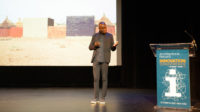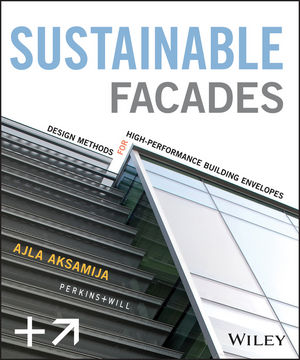
At the start of a day devoted to the connections between architecture and new technology, Elizabeth Diller, of Diller Scofidio + Renfro, urged architects to continue to use “the whole repertoire of old-fashioned tools that are not really getting replaced, just supplemented.” She described the firm’s best-known project, the High Line, as low-tech, and said the popularity of Blur—its first building “for a mass audience”—could be explained by the structure’s simplicity. She conceded that one of the firm’s newest projects, a cinch-waisted condo tower in Manhattan’s Hudson Yards, could not have been designed without CATIA (Computer Aided Three-dimensional Interactive Application), the CAD program that has its origins in aircraft fabrication. Still, she argued, technology shouldn’t be seen as itself a generator of architectural forms so much as ”an agent” to be used “with other, dumber systems.”
 |
|
Photo © Steve Hill
Ole Scheeren, principal of Buro Ole Scheeren, explained how innovative cores helped generate the startling forms of several of his buildings.
|
The challenge Diller described—finding simplicity in a world of dizzying technological innovation—set the tone for the 11th annual Architectural Record Innovation Conference, which drew 400 people to the auditorium of Manhattan's McGraw-Hill Building on October 3. True, Ole Scheeren couldn’t describe CCTV, the five-million-square-foot building he and Rem Koolhaas designed to cantilever over Beijing, as simple, but he did make a strong case that its form grew directly out of its function. And he traced the history of the “service core,” which is part of every skyscraper, to a house designed by “domestic economist” Catharine Beecher in the 1860s. Exploring what he called “core values,” he explained how innovative cores helped generate the startling forms of several of his buildings, including a housing development in Singapore made of tower blocks arranged lengthwise around hexagonal courtyards, and a skyscraper in Bangkok that looks as though parts of it have blown away.
Among architects who spoke during the daylong conference, perhaps the one most clearly indebted to technology was Thom Mayne. The Pritzker Prize-winner (who said that outside the office he is techno-challenged, unable to turn on the television) described the arc of his career in terms of what CAD has made possible. Recalling the days when he conceived of buildings as plans, elevations, and sections, he said those drawings are now just digital “outputs,” and that the latest software is “allowing us to change the direction of architecture aesthetically.” He can now create buildings that are neither drawable nor even “preconceivable.”
David Rockwell, of Rockwell Group; Lise Anne Couture, of Asymptote Architecture; and Keith Besserud of Skidmore, Owings & Merrill (SOM) spoke of ways they integrate the latest research into their architectural practices. But another representative of SOM, structural engineering partner William F. Baker, described the firm’s intensive research into an initiative that sounds almost retro—creating tall buildings with timber frames. Other speakers commented on the connections between technology and craft. As Chris Sharples of SHoP Architects noted, digital tools are helping to connect innovative architects with artisans. Aleksey Lukyanov-Cherny of the firm Situ Studio said, “What technology is doing is not removing the hand—it’s actually allowing more hands to participate.”
Among the most provocative presenters of the day were the members of a panel on how “big data,” the vast amount of information available to architects and planners, can shape the physical world. As moderator and author Andrew Blum stated, “Data has spatial consequences.” Anthony Townsend, a researcher and author, spoke of systems that will help control cities of “tens of millions of people,” noting, for example, that cellphone usage data allowed Istanbul to redesign its bus network, matching routes to demand without the need for cumbersome market research. Another panelist, law professor Susan P. Crawford, said the effects of supplying the entire country with fiber optic lines will be as profound as those that resulted from the advent of electricity.
It was Mayne who ended the program, noting that digital tools, by eliminating the need to design in two dimensions, have helped architects rediscover what their profession is about. “As architects, we don’t draw drawings,” he said. “We make buildings.”





